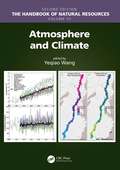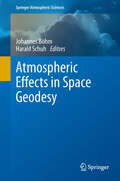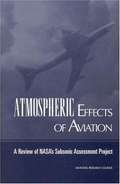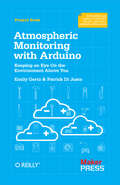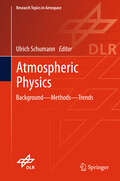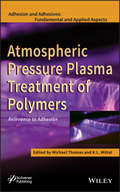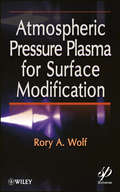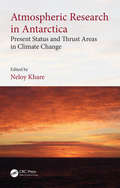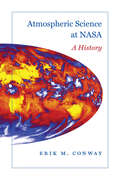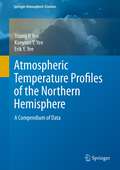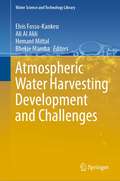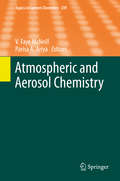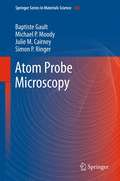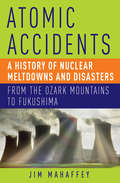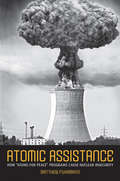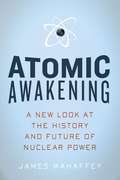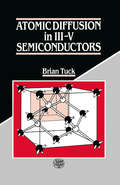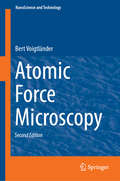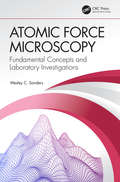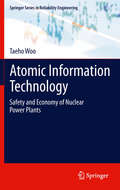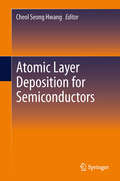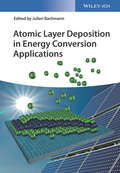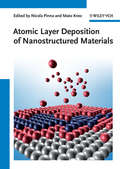- Table View
- List View
Atmosphere and Climate
by Yeqiao WangAuthored by world-class scientists and scholars, The Handbook of Natural Resources, Second Edition, is an excellent reference for understanding the consequences of changing natural resources to the degradation of ecological integrity and the sustainability of life. Based on the content of the bestselling and CHOICE-awarded Encyclopedia of Natural Resources, this new edition demonstrates the major challenges that the society is facing for the sustainability of all well-being on the planet Earth. The experience, evidence, methods, and models used in studying natural resources are presented in six stand-alone volumes, arranged along the main systems of land, water, and air. It reviews state-of-the-art knowledge, highlights advances made in different areas, and provides guidance for the appropriate use of remote sensing and geospatial data with field-based measurements in the study of natural resources. Volume 6, Atmosphere and Climate, covers atmospheric pollution and the complexity of atmospheric systems and their interactions with human activity. As an excellent reference for fundamental information on air systems, the handbook includes coverage of acid rain and nitrogen deposition, air pollutants, elevated carbon dioxide, atmospheric circulation patterns, and climate change effects on polar regions and climatology. New in this edition are discussions on aerosols monitoring and mapping, greenhouse gases, the Greenland ice sheet, and mountainous regions. This book presents the key processes, methods, and models used in studying the impact of air pollution on ecosystems worldwide. Written in an easy-to-reference manner, The Handbook of Natural Resources, Second Edition, as individual volumes or as a complete set, is an essential reading for anyone looking for a deeper understanding of the science and management of natural resources. Public and private libraries, educational and research institutions, scientists, scholars, and resource managers will benefit enormously from this set. Individual volumes and chapters can also be used in a wide variety of both graduate and undergraduate courses in environmental science and natural science at different levels and disciplines, such as biology, geography, earth system science, and ecology.
Atmospheric Acoustic Remote Sensing: Principles and Applications
by Stuart BradleySonic Detection and Ranging (SODAR) systems and Radio Acoustic Sounding Systems (RASS) use sound waves to determine wind speed, wind direction, and turbulent character of the atmosphere. They are increasingly used for environmental and scientific applications such as analyzing ground-level pollution dispersion and monitoring conditions affecting wi
Atmospheric Effects in Space Geodesy (Springer Atmospheric Sciences)
by Harald Schuh Johannes BöhmVarious effects of the atmosphere have to be considered in space geodesy and all of them are described and treated consistently in this textbook. Two chapters are concerned with ionospheric and tropospheric path delays of microwave and optical signals used by space geodetic techniques, such as the Global Navigation Satellite Systems (GNSS), Very Long Baseline Interferometry (VLBI), or Satellite Laser Ranging (SLR). It is explained how these effects are best reduced and modelled to improve the accuracy of space geodetic measurements. Other chapters are on the deformation of the Earth's crust due to atmospheric loading, on atmospheric excitation of Earth rotation, and on atmospheric effects on gravity field measurements from special satellite missions such as CHAMP, GRACE, and GOCE. All chapters have been written by staff members of the Department of Geodesy and Geoinformation at TU Wien who are experts in the particular fields.
Atmospheric Effects of Aviation: A Review of NASA's Subsonic Assessment Project
by Panel on Atmospheric Effects of AviationA review of the Atmospheric Effects of Aviation
Atmospheric Monitoring with Arduino: Building Simple Devices to Collect Data About the Environment
by Emily Gertz Patrick Di JustoMakers around the globe are building low-cost devices to monitor the environment, and with this hands-on guide, so can you. Through succinct tutorials, illustrations, and clear step-by-step instructions, you’ll learn how to create gadgets for examining the quality of our atmosphere, using Arduino and several inexpensive sensors.Detect harmful gases, dust particles such as smoke and smog, and upper atmospheric haze—substances and conditions that are often invisible to your senses. You’ll also discover how to use the scientific method to help you learn even more from your atmospheric tests.Get up to speed on Arduino with a quick electronics primerBuild a tropospheric gas sensor to detect carbon monoxide, LPG, butane, methane, benzene, and many other gasesCreate an LED Photometer to measure how much of the sun’s blue, green, and red light waves are penetrating the atmosphereBuild an LED sensitivity detector—and discover which light wavelengths each LED in your Photometer is receptive toLearn how measuring light wavelengths lets you determine the amount of water vapor, ozone, and other substances in the atmosphereUpload your data to Cosm and share it with others via the Internet"The future will rely on citizen scientists collecting and analyzing their own data. The easy and fun gadgets in this book show everyone from Arduino beginners to experienced Makers how best to do that."--Chris Anderson, Editor in Chief of Wired magazine, author of Makers: The New Industrial Revolution (Crown Business)
Atmospheric Physics: Background – Methods – Trends (Research Topics in Aerospace)
by Ulrich SchumannOn the occasion of the 50th anniversary of the Institute of Atmospheric Physics of the German Aerospace Center (DLR), this book presents more than 50 chapters highlighting results of the institute's research.The book provides an up-to-date, in-depth survey across the entire field of atmospheric science, including atmospheric dynamics, radiation, cloud physics, chemistry, climate, numerical simulation, remote sensing, instruments and measurements, as well as atmospheric acoustics. The authors have provided a readily comprehensible and self-contained presentation of the complex field of atmospheric science. The topics are of direct relevance for aerospace science and technology. Future research challenges are identified.
Atmospheric Pressure Plasma Treatment of Polymers: Relevance to Adhesion
by Michael Thomas K. L. MittalThe Atmospheric Pressure Plasma (APP) treatment for polymer surface modification has attracted much attention recently, owing to its advantages over other techniques and its ability to improve adhesion without tampering with polymer's bulk properties. Focusing on the utility of APP treatment for enhancing polymer adhesion, this book covers the latest development in this important and enabling technology, providing profound insights from many top researchers on the design and functions of various types of reactors, as well as current and potential applications of APP treatment.
Atmospheric Pressure Plasma for Surface Modification
by Rory A. WolfThis Book's focus and intent is to impart an understanding of the practical application of atmospheric plasma for the advancement of a wide range of current and emerging technologies. The primary key feature of this book is the introduction of over thirteen years of practical experimental evidence of successful surface modifications by atmospheric plasma methods. It offers a handbook-based approach for leveraging and optimizing atmospheric plasma technologies which are currently in commercial use. It also offers a complete treatment of both basic plasma physics and industrial plasma processing with the intention of becoming a primary reference for students and professionals. The reader will learn the mechanisms which control and operate atmospheric plasma technologies and how these technologies can be leveraged to develop in-line continuous processing of a wide variety of substrates. Readers will gain an understanding of specific surface modification effects by atmospheric plasmas, and how to best characterize those modifications to optimize surface cleaning and functionalization for adhesion promotion. The book also features a series of chapters written to address practical surface modification effects of atmospheric plasmas within specific application markets, and a commercially-focused assessment of those effects.
Atmospheric Research in Antarctica: Present Status and Thrust Areas in Climate Change
by Neloy KhareAtmospheric Research in Antarctica: Present Status and Thrust Areas in Climate Change represents a panoramic view of the developments in the field of Antarctic atmospheric sciences and meteorology broadly covering geomagnetism and aeronomy, middle atmospheric studies and global and climate change studies. It includes greenhouse gases, ozone monitoring as well as very low frequency (VLF) phenomena, and space weather, Antarctic meteorology, and mathematical modeling of atmosphere and ocean processes around Antarctica. Atmospheric electricity and aerosols investigations over Antarctica along with the total solar eclipse-related studies, calibration of AWIFS Sensor, and measurements of positive ions, are also discussed. This book is aimed at researchers and graduate students in atmospheric studies, meteorology, Antarctic studies, climate change. FEATURES: Covers scientific aspects of Antarctic meteorology and atmospheric sciences under climate change scenario Contains diverse set of information with strong bearing on recent and past polar processes Presents integrated research on polar science coupled with meteorological, climatological and atmosphericsciences Thoroughly reviews geomagnetism and aeronomy, middle atmospheric studies including global and climate change studies Helps readers understand how Antarctica’s climate has changed in the past and is being affected by ‘global warming’ and how might we expect its climate to change in the future?
Atmospheric Science at NASA: A History (New Series in NASA History)
by Erik M. ConwayHonorable Mention, 2008 ASLI Choice Awards. Atmospheric Science Librarians InternationalThis book offers an informed and revealing account of NASA’s involvement in the scientific understanding of the Earth’s atmosphere. Since the nineteenth century, scientists have attempted to understand the complex processes of the Earth’s atmosphere and the weather created within it. This effort has evolved with the development of new technologies—from the first instrument-equipped weather balloons to multibillion-dollar meteorological satellite and planetary science programs. Erik M. Conway chronicles the history of atmospheric science at NASA, tracing the story from its beginnings in 1958, the International Geophysical Year, through to the present, focusing on NASA’s programs and research in meteorology, stratospheric ozone depletion, and planetary climates and global warming. But the story is not only a scientific one. NASA’s researchers operated within an often politically contentious environment. Although environmental issues garnered strong public and political support in the 1970s, the following decades saw increased opposition to environmentalism as a threat to free market capitalism. Atmospheric Science at NASA critically examines this politically controversial science, dissecting the often convoluted roles, motives, and relationships of the various institutional actors involved—among them NASA, congressional appropriation committees, government weather and climate bureaus, and the military.
Atmospheric Temperature Profiles of the Northern Hemisphere: A Compendium of Data (Springer Atmospheric Sciences)
by Young Yee Erik Y. Yee Kueyson Y. YeeFor more than three decades, the US Standard Atmosphere has been used by researchers and professionals in many areas of aeronautics and atmospheric sciences. It is an idealized, all season average temperature profile of the earth's atmosphere. But today's modern day and sophisticated global applications require more extensive representations of the mean temperature profile. This book is a global augmentation of the climatological tropospheric temperature profiles in the Northern Hemisphere for different latitude belts and seasons. There are 72 mean temperature profile tables from the surface up to 10 kilometers in height that represent the four seasons for different latitudinal belts (5° N, 10° N , 15° N, 20° N, 25° N, 30° N, 35° N, 40° N, 45° N, 50° N, 55° N, 60° N, 65° N, 70° N, 75° N, 80° N, 85° N). The model is based on a neural network algorithm that uses archived radiosonde data, retrieved temperature profiles from remote sensors, and the solar insolation at the top of the earth's atmosphere. It is the most comprehensive book of mean seasonal tropospheric temperature profiles to date. It will be an indispensible reference to the aeronautic and meteorological industries worldwide as well as an easy-to-use guide for climatologists, meteorologists, aeronautic engineers, researchers and aviators.
Atmospheric Water Harvesting Development and Challenges (Water Science and Technology Library #122)
by Elvis Fosso-Kankeu Bhekie Mamba Ali Al Alili Hemant MittalThe commercial operation of atmospheric water harvesting systems is still limited to few countries; this is mainly due to the low energy efficiency of the system and the inability to effectively operate throughout the various seasons of the year. Researchers have attempted to develop strategies to render the operation of atmospheric water harvesters easier and cost effective. This book covers work progress toward such direction, including among others the co-operation of these systems with renewable energy source and the adaptation of the systems to local conditions; the response of the communities around the world to such technology and how its implementation is affected by cultural believe, cost, and technological friendliness. The book is of interest to academic researchers, students, water authorities, professional in relevant industries, government regulatory bodies officers, and environmentalists.
Atmospheric and Aerosol Chemistry (Topics in Current Chemistry #339)
by V. Faye Mcneill Parisa A. AriyaChristian George, Barbara D'Anna, Hartmut Herrmann, Christian Weller, Veronica Vaida, D. J. Donaldson, Thorsten Bartels-Rausch, Markus Ammann - Emerging Areas in Atmospheric Photochemistry. Lisa Whalley, Daniel Stone, Dwayne Heard - New Insights into the Tropospheric Oxidation of Isoprene: Combining Field Measurements, Laboratory Studies, Chemical Modelling and Quantum Theory. Neil M. Donahue, Allen L. Robinson, Erica R. Trump, Ilona Riipinen, Jesse H. Kroll - Volatility and Aging of Atmospheric Organic Aerosol. P. A. Ariya, G. Kos, R. Mortazavi, E. D. Hudson, V. Kanthasamy, N. Eltouny, J. Sun, C. Wilde - Bio-Organic Materials in the Atmosphere and Snow: Measurement and Characterization. V. Faye McNeill, Neha Sareen, Allison N. Schwier - Surface-Active Organics in Atmospheric Aerosols.
Atom Optics with Laser Light (Laser Science And Technology Ser.)
by V.S. LetokhovThis book deals specifically with the manipulation of atoms by laser light, describing the focusing, channeling and reflection of atoms by laser fields. It also describes the potential fields required to cause the phase change of the wave function necessary for the atomic interactions to occur.
Atom Probe Microscopy (Springer Series in Materials Science #160)
by Michael P. Moody Julie M. Cairney Baptiste Gault Simon P. RingerAtom probe microscopy enables the characterization of materials structure and chemistry in three dimensions with near-atomic resolution. This uniquely powerful technique has been subject to major instrumental advances over the last decade with the development of wide-field-of-view detectors and pulsed-laser-assisted evaporation that have significantly enhanced the instrument's capabilities. The field is flourishing, and atom probe microscopy is being embraced as a mainstream characterization technique. This book covers all facets of atom probe microscopy--including field ion microscopy, field desorption microscopy and a strong emphasis on atom probe tomography. Atom Probe Microscopy is aimed at researchers of all experience levels. It will provide the beginner with the theoretical background and practical information necessary to investigate how materials work using atom probe microscopy techniques. This includes detailed explanations of the fundamentals and the instrumentation, contemporary specimen preparation techniques, experimental details, and an overview of the results that can be obtained. The book emphasizes processes for assessing data quality, and the proper implementation of advanced data mining algorithms. Those more experienced in the technique will benefit from the book as a single comprehensive source of indispensable reference information, tables and techniques. Both beginner and expert will value the way that Atom Probe Microscopy is set out in the context of materials science and engineering, and includes references to key recent research outcomes.
Atomic Accidents: A History of Nuclear Meltdowns and Disasters: From the Ozark Mountains to Fukushima
by James MahaffeyFrom the moment radiation was discovered in the late nineteenth century, nuclear science has had a rich history of innovative scientific exploration and discovery, coupled with mistakes, accidents, and downright disasters. Mahaffey, a long-time advocate of continued nuclear research and nuclear energy, looks at each incident in turn and analyzes what happened and why, often discovering where scientists went wrong when analyzing past meltdowns. Every incident has lead to new facets in understanding about the mighty atom--and Mahaffey puts forth what the future should be for this final frontier of science that still holds so much promise.
Atomic Assistance
by Matthew FuhrmannNuclear technology is dual use in nature, meaning that it can be used to produce nuclear energy or to build nuclear weapons. Despite security concerns about proliferation, the United States and other nuclear nations have regularly shared with other countries nuclear technology, materials, and knowledge for peaceful purposes. In Atomic Assistance, Matthew Fuhrmann argues that governments use peaceful nuclear assistance as a tool of economic statecraft. Nuclear suppliers hope that they can reap the benefits of foreign aid-improving relationships with their allies, limiting the influence of their adversaries, enhancing their energy security by gaining favorable access to oil supplies-without undermining their security. By providing peaceful nuclear assistance, however, countries inadvertently help spread nuclear weapons. Fuhrmann draws on several cases of "Atoms for Peace," including U.S. civilian nuclear assistance to Iran from 1957 to 1979; Soviet aid to Libya from 1975 to 1986; French, Italian, and Brazilian nuclear exports to Iraq from 1975 to 1981; and U.S. nuclear cooperation with India from 2001 to 2008. He also explores decision making in countries such as Japan, North Korea, Pakistan, South Africa, and Syria to determine why states began (or did not begin) nuclear weapons programs and why some programs succeeded while others failed. Fuhrmann concludes that, on average, countries receiving higher levels of peaceful nuclear assistance are more likely to pursue and acquire the bomb-especially if they experience an international crisis after receiving aid.
Atomic Awakening: A New Look at the History and Future of Nuclear Power
by James MahaffeyThe American public's introduction to nuclear technology was manifested in destruction and death. With Hiroshima and the Cold War still ringing in our ears, our perception of all things nuclear is seen through the lens of weapons development. Nuclear power is full of mind-bending theories, deep secrets, and the misdirection of public consciousness, some deliberate, some accidental. The result of this fixation on bombs and fallout is that the development of a non-polluting, renewable energy source stands frozen in time. It has been said that if gasoline were first used to make napalm bombs, we would all be driving electric cars. Our skewed perception of nuclear power is what makes James Mahaffey's new look at the extraordinary paradox of nuclear power so compelling. From medieval alchemy to Marie curie, Albert Einstein, and the Manhattan Project, atomic science is far from the spawn of a wicked weapons program. The discovery that the atom can be split brought forth the ultimate puzzle of the modern age: Now that the energy of the universe is available to us, how do we use it? For death and destruction? Or as a fuel for our society that has minimal impact on the environment and future generations? Outlining nuclear energy's discovery and applications throughout history, Mahaffey's brilliant and accessible book is essential to understanding the astounding phenomenon of nuclear power in an age where renewable energy and climate change have become the defining concerns of the twenty-first century.
Atomic Diffusion in III-V Semiconductors
by Brian TuckIII-V semiconductors, of which gallium arsenide is the best known, have been important for some years and appear set to become much more so in the future. They have principally contributed to two technologies: microwave devices and optoelectronics. Recent advances in the production of thin layers have made possible a whole new range of devices based on multi-quantum wells. The heat treatments used in the manufacture of semiconductor devices means that some diffusion must take place. A good understanding of diffusion processes is therefore essential to maintain control over the technology. Atomic Diffusion in III-V Semiconductors presents a lucid account of the experimental work that has been carried out on diffusion in III-Vs and explores the advanced models that explain the results. A review of the III-V group of semiconductors outlines the special properties that make them so attractive for some types of devices. Discussion of the basic elements of diffusion in semiconductors provides the theory necessary to understand the subject in depth, and the book gives hints on how to assess the published data. Chapters on diffusion of shallow donors, shallow acceptors, transition elements, and very fast-diffusing elements provide a critical review of published works. The book also presents the neglected subject of self-diffusion, including a section on superlattices. Atomic Diffusion in III-V Semiconductors will be of interest to research workers in semiconductor science and technology, and to postgraduate students in physics, electronics, and materials science.
Atomic Force Microscopy (NanoScience and Technology)
by Bert VoigtländerThis book explains the operating principles of atomic force microscopy with the aim of enabling the reader to operate a scanning probe microscope successfully and understand the data obtained with the microscope. This enhanced second edition to "Scanning Probe Microscopy" (Springer, 2015) represents a substantial extension and revision to the part on atomic force microscopy of the previous book. Covering both fundamental and important technical aspects of atomic force microscopy, this book concentrates on the principles the methods using a didactic approach in an easily digestible manner. While primarily aimed at graduate students in physics, materials science, chemistry, nanoscience and engineering, this book is also useful for professionals and newcomers in the field, and is an ideal reference book in any atomic force microscopy lab.
Atomic Force Microscopy: Fundamental Concepts and Laboratory Investigations
by Wesley C. SandersThis book focuses primarily on the atomic force microscope and serves as a reference for students, postdocs, and researchers using atomic force microscopes for the first time. In addition, this book can serve as the primary text for a semester-long introductory course in atomic force microscopy. There are a few algebra-based mathematical relationships included in the book that describe the mechanical properties, behaviors, and intermolecular forces associated with probes used in atomic force microscopy. Relevant figures, tables, and illustrations also appear in each chapter in an effort to provide additional information and points of interest. This book includes suggested laboratory investigations that provide opportunities to explore the versatility of the atomic force microscope. These laboratory exercises include opportunities for experimenters to explore force curves, surface roughness, friction loops, conductivity imaging, and phase imaging.
Atomic Information Technology: Safety and Economy of Nuclear Power Plants (Springer Series in Reliability Engineering)
by Taeho WooAtomic Information Technology revaluates current conceptions of the information technology aspects of the nuclear industry. Economic and safety research in the nuclear energy sector are explored, considering statistical methods which incorporate Monte-Carlo simulations for practical applications. Divided into three sections, Atomic Information Technology covers: Atomic economics and management, Atomic safety and reliability, and Atomic safeguarding and security. Either as a standalone volume or as a companion to conventional nuclear safety and reliability books, Atomic Information Technology acts as a concise and thorough reference on statistical assessment technology in the nuclear industry. Students and industry professionals alike will find this a key tool in expanding and updating their understanding of this industry and the applications of information technology within it.
Atomic Layer Deposition for Semiconductors
by Cheol Seong HwangOffering thorough coverage of atomic layer deposition (ALD), this book moves from basic chemistry of ALD and modeling of processes to examine ALD in memory, logic devices and machines. Reviews history, operating principles and ALD processes for each device.
Atomic Layer Deposition in Energy Conversion Applications
by Julien BachmannCombining the two topics for the first time, this book begins with an introduction to the recent challenges in energy conversion devices from a materials preparation perspective and how they can be overcome by using atomic layer deposition (ALD). By bridging these subjects it helps ALD specialists to understand the requirements within the energy conversion field, and researchers in energy conversion to become acquainted with the opportunities offered by ALD. With its main focus on applications of ALD for photovoltaics, electrochemical energy storage, and photo- and electrochemical devices, this is important reading for materials scientists, surface chemists, electrochemists, electrotechnicians, physicists, and those working in the semiconductor industry.
Atomic Layer Deposition of Nanostructured Materials
by Mato Knez Nicola PinnaAtomic layer deposition, formerly called atomic layer epitaxy, was developed in the 1970s to meet the needs of producing high-quality, large-area fl at displays with perfect structure and process controllability. Nowadays, creating nanomaterials and producing nanostructures with structural perfection is an important goal for many applications in nanotechnology. As ALD is one of the important techniques which offers good control over the surface structures created, it is more and more in the focus of scientists. The book is structured in such a way to fi t both the need of the expert reader (due to the systematic presentation of the results at the forefront of the technique and their applications) and the ones of students and newcomers to the fi eld (through the first part detailing the basic aspects of the technique). This book is a must-have for all Materials Scientists, Surface Chemists, Physicists, and Scientists in the Semiconductor Industry.
